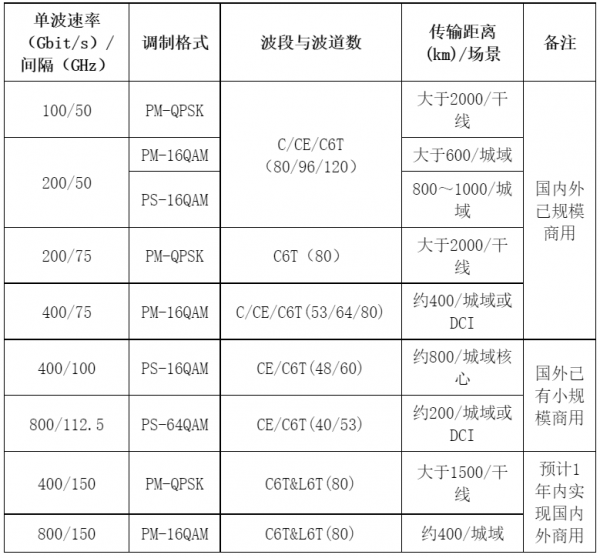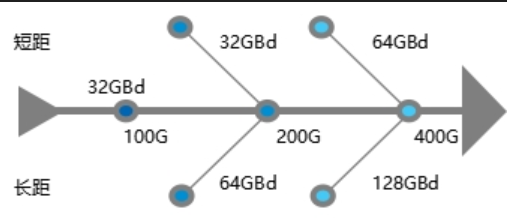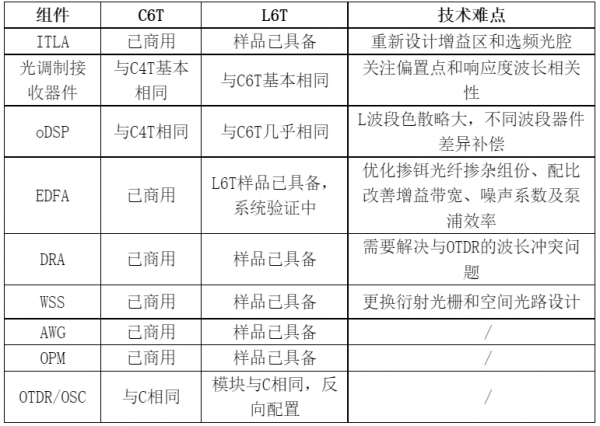400G optical transmission core technology and industrial development progress
At present, the Internet of telecom companies is facing challenges from Internet transformation, bandwidth improvement and other aspects. Therefore, improving the distance between the single wave speed and transmission of the optical transmission control system and improving the bandwidth utilization of the broadband communication control system to meet the growing demand for Internet traffic has become the common pursuit of telecom companies and equipment manufacturers.
At this stage, the industry is improving in three dimensions, accelerating the evolution of backbone Gu Zuolin to 80 × 400G social relations.
First, speed is improved. The backbone network evolves from 10G to 100G and then to 200G, with the distance basically unchanged and the power consumption continues to multiply. At present, under the background of router port speed increase, it has entered the era of 400G ports, and domestic and foreign telecommunications companies have launched tests and inspections. 2023 will usher in the application field of backbone 400G OTN.
Second, power consumption has increased. When the backbone Gu Zuolin speeds up to 200G, it will occupy 75GHz spectral width, and when it develops to 400G QPSK (Quadrature Phase Shift Keying), it will occupy 150GHz spectral width. The working efficiency of 400G frequency band has not improved compared with 200G frequency band, breaking the rule that the original 10G to 100G frequency band remains unchanged while the power consumption increases by 10 times; Affected by Shannon's limit, it is necessary to open up new paths to improve the overall broadband transmission power consumption. The most practical plan at present is to expand the C+L band, mainly including: the C6T&L5T 11THz band expansion plan, which has completed honey transport test; As well as the C6T&L6T 12THz frequency band expansion plan, the laboratory test capability has been available at this stage, and honey transportation test will be completed soon, and the control system operability optimization will continue. In the 80 × 800G control system, the frequency band will be further considered to be extended to S+C+L+U band wave. At the same time, with the increase of backbone network speed, new broadband core technologies such as multi-core broadband, few mode broadband and hollow core broadband are required to be used together to ensure the distance between trunk lines.
Third, improve the efficiency. In the 400G/800G era, new DSP core technology is used to support switching of multiple baud rates and modulation modes, achieve the optimal adaptation of the same power consumption at the same phase distance in a software defined way, and maximize the power consumption phase distance product and band efficiency.
Single wave ultra 400G core technology detection method
For the same application field scenarios such as TNUMBERG16 and trunk lines, the 400G transmission control system uses the same core technology, which can simultaneously achieve the balance of transmission controllability, band efficiency and cost. Table 1 lists the characteristics and capabilities of the main single wave speed control systems. 100G and super 100G core technologies have obvious social relationship characteristics. In the engineering application field, the next generation of speed short-range components and the previous generation of speed long-distance components share the supply chain, so that the supply chain can be unified at the same time.
Table 1 Features and capabilities of the same single wave speed control system

As shown in Figure 1, 200G PM-16QAM and 100G PM-QPSK have 32G baud rate supply chain, 400G PM-16QAM and 200G PM-QPSK have 64G baud rate supply chain, 400G PM-QPSK and future 800G PM-16QAM have 128G baud rate supply chain.

Figure 1 Schematic Diagram of the Normalization of Long distance and Short distance Supply Chain
At present, 200G QPSK has been widely used for civilian use. The 400G 16QAM of the 64G baud rate supply chain can meet the TNUMBERG16 transmission demand. At present, the core technology of 400G transmission is 16QAM (Probabilistic Shaping, PS) at 96G baud rate, and finally evolves into the QPSK plan at 128G baud rate. Compared with the 400G PS 16QAM, the 400G QPSK back-to-back OSNR controllability is about 1dB better, and the input fiber output power is more than 1dB higher, which can cover various trunk long-distance transmission scenarios and share the supply chain with the future 800G 16QAM.
From the chip level, the core technology of coherent oDSP has gone through several social relationships. The differences in the same social relationships are mainly reflected in the maximum speed of single wave, modulation code, size and power consumption. At present, the 400G 16QAM oDSP chip uses a 7nm manufacturing process, consumes about 8W and supports 64G baud rate. For the next generation of remote 400G applications, the head oDSP manufacturer has released a single wave 1.2T product roadmap or even component samples, which supports up to 140G baud rate and uses a 5nm wafer process.
From all aspects of oDSP algorithm, Scorpio shaping and high controllability FEC codec algorithm are key. Scorpio shaping can be divided into Geometric Shaping (GS) and Probabilistic Shaping (PS), as shown in Figure 2 (a) and Figure 2 (b) respectively. GS and PS respectively change the position and occurrence probability of Scorpio points to make them show special distribution and provide better maneuverability than conventional QAM.

Fig. 2 Scorpio plastic surgery
The core technology of high controllability error correction code (FEC) can obtain higher net code impedance by using concatenated code, soft decision and multiple iterative decoding.
High controllability photoelectric element is the basis of realizing high fidelity conversion from electrical signal to optical signal at the same time. In the field of long-distance 400G optical transmission applications, the baud rate of the control system is greater than 100Gbd, and the bandwidth of optical elements needs to be more than 50GHz. At this stage, mainstream suppliers have carried out research on miniaturization, integration and large bandwidth optical transceiver components based on the Silicon Photonics (SiP) or Indium Phosphoride (InP) process platform, and launched some quasi civilian samples.
Advanced component PCB core technology is also an important means to optimize the bandwidth of optoelectronic chips. At present, the 3dB bandwidth of the modulator can be increased from 30GHz to over 80GHz by integrating the Peak function of Driver and the optimization of 2.5D/3DPCB process. This can improve the back-to-back OSNR tolerance of more than 2dB for ultra 400G high-order modulation signals, and this core technology has become increasingly mature, further accelerating the civil process of 128 Gbd remote 400G control system.
In all aspects of the core components of the optical control system, optical amplifier (OA) and wavelength selective switch (WSS) are the most critical. At present, civil OA is mainly based on erbium doped fiber amplifier (EDFA), which supports C-band 4THz, 4.8THz and even 6THz bandwidth. The L-band EDFA is also under development. The L-band 5THzEDFA sample has passed the honey transportation test. The core technical bottleneck of L-band 6THz amplification has been broken through. The sample single machine operability meets the expectations. The control system level operability test and optimization is under way. However, due to the amplification efficiency of erbium-doped broadband at the long wave, the noise index of EDFA in the extended L-band may be more than 1dB worse than that in the extended C-band, and the cost and size of components will also increase accordingly.
At this stage, the civil WSS has covered the C-band 6THz, with typical insertion loss of about 6dB, and the number of ports up to 32. Using the latest high resolution liquid crystal on silicon (LCoS) core technology, WSS's band slice resolution is 6.25GHz, and several manufacturers have expanded the operating band to L-band 6THz.
In all aspects of the progress of international standards, the 15th Research Group of the International Telecommunication Union (ITU-T SG15) carried out the research on the physical layer specifications of 200G and 400G interfaces, and took PM-16QAM as the international standard code in the application field of 400GTNUMBER G16, which promoted the international standardization process of opening forward error correction code (oFEC). In addition, multiple multi source agreement organizations (MSA) in the industry have also successively released international standards for core technologies exceeding 100G. For example, OpenROADM/OpenZR+released the specification of 100~400G coherent optical components, which supports CFP2-DCO and QSFP-DD/OSFPPCB, adds 100/200G QPSK, 300G 8QAM and other modulation modes on the basis of 400ZR frame structure, and uses oFEC instead of cascade FEC (cFEC) to support 400G transmission at 450km level. The development of relevant international standards of China Communications International Standardization Association (CCSA) includes: the development of international standards for optical transmission and components at speeds of 100G and below has been completed, the 200G draft for approval mainly selects 200G QPSK, 8QAM, 16QAM code types, the 400GTNUMBER G16 international standard essentially uses the single wave 200G dual carrier plan, and N × 400G long distance enhanced optical wavelength division multiplexing (WDM) Research on core technical requirements of control system and other international standard topics facing higher speed applications have been completed, and it is clearly pointed out that QPSK is an ideal solution plan to realize single wave 400Gb/s long-distance/ultra long-distance simultaneously.
Detection method for core technology of frequency band expansion
The core technology of frequency band expansion is to inherit the DWDM idea, further expand the available transmission bandwidth beyond the traditional C-band, and increase the power consumption of single fiber transmission by increasing the number of channels transmitted by the common fiber. On the basis of traditional C-band DWDM, China's telecommunications companies and equipment manufacturers have led the expansion of Super C-band (C6T) in the past two years, increasing the bandwidth of C-band from 4THz/4.8THz to 6THz, and implementing the 200G QPSK plan with 80 wave 75GHz interval. In fact, the low loss window of single-mode broadband includes not only the C band, but also the O, E, S, L, U and other bands. In recent years, a few telecom companies and Internet manufacturers in the United States have deployed C+L control systems in DCI and submarine cable transmission, which can double the broadband power consumption. With the power consumption of single-mode broadband approaching the Shannon limit of 100Tbit/s, the core technology of band expansion has become a hot spot in academic and industrial research. At present, domestic telecom companies and equipment manufacturers are actively promoting the upgrading of C6T to C6T&L6, with a view to providing a single fiber 80 wave 400G QPSK long-distance transmission capability. The basic architecture of the multi band optical transmission control system is shown in Figure 3.

Figure 3 Basic Architecture of Multi band Optical Transmission Control System
The development of C+L related supply chains at this stage is shown in Table 2. It can be seen that, with the breakthrough of core technical difficulties, the development progress of C+L expanding the frequency band optical component supply chain is in line with expectations, and the new generation of C6T+L6T's 12THz broadband optical layer combined with the single wave 400G QPSK optical control system is expected to usher in civil deployment within one year.
Table 2 Supply Chain Progress of Key Components of C6T&L6T Control System

The transfer of SRS effect in broadband is significantly enhanced with the expansion of the bandwidth and the increase of the input fiber output power, and has a cross segment cumulative effect; C+L control system not only needs fine optical output power management strategy, but also realizes effective control of impedance and slope at the beginning to compensate for the uneven output power caused by SRS; Filling wave configuration is also required to keep the control system fully configured at all times, so as to reduce the impact of dynamic increase and decrease of services on existing services. Using the experience of submarine cable control system for reference, when adding or deleting channels, it is only necessary to "replace the true with the false" with the service signal and the filling wave, and the service commissioning is convenient and fast.
Before output power regulation, due to strong SRS output power transfer in the C+L control system, the smoothness of single wave output power at the end of the control system deteriorated seriously, which could not meet the requirements of the control system application field. After the impedance and impedance slope of the EDFA are adjusted by using the C+L output power pre equalization strategy, the output power smoothness, OSNR smoothness, and minimum OSNR of the control system are significantly improved. The automatic output power adjustment algorithm and filling wave configuration have been fully tested in honeymoon tests, laying the foundation for subsequent civilian deployment.
Detection method of single wave 400G control system
As early as 2018, China Mobile carried out the test work on the use of single carrier 400G 16QAM by joint equipment manufacturers in honey transportation, and simultaneously realized the transmission distance of up to 600km. In October 2021, China Mobile, together with Huawei, ZTE, Fiberhome and other equipment manufacturers, will complete the world's first GT630M spectrum single wave 400G high power consumption optical transmission test in Honeytrans, and achieve a transmission distance of more than 1000 km. In July 2022, China Mobile and ZTE will work together to simulate the broadband length, loss and maintenance margin of Honeytrans in the laboratory, carry out 400G QPSK transmission inspection based on Honeytrans requirements, and achieve a transmission distance of 3038km for 49 cross section powerless relays. Based on the laboratory test results, in January 2023, China Mobile carried out the 400G QPSK honey transport test, spanning four provinces of Zhejiang, Jiangxi, Hunan and Guizhou, involving 45 optical amplification sections, while realizing 5616km long distance real-time honey transport on land, creating a new record of 400G QPSK power free relay honey transport distance, and testing the 12THz transmission operability of the bandwidth expansion to C6T+L6T for the first time.
Facing the Internet of Computing Power and the layout of "East Data and West Computing", it is necessary to promote the research and development of 400G key core technologies, while achieving comprehensive core technology innovation in modulation, frequency band and infrastructure. In the future, China Mobile will work with its industry partners to maintain in-depth cooperation in 400G QPSK long distance transmission, C6T+L6TGT630M spectrum band expansion, optoelectronic linkage all-optical networking core technology and other aspects, promote the research and breakthrough of key core technologies such as ultra-high speed, ultra long distance, ultra large power consumption, and GT630M band, and help OTN Internet move towards large bandwidth, low delay, efficiency, flexibility The direction of security and reliability evolves, while realizing all optical high-speed interconnection and all optical flexible scheduling of Computational Internet. On this basis, we will continue to promote the evolution of the core technology of the new generation of optical communications, build a solid all-optical base for the computing power Internet, and contribute to the development of the digital economy.




